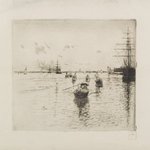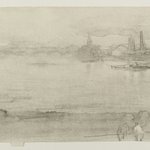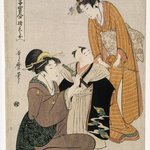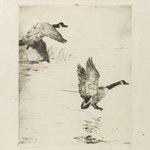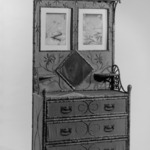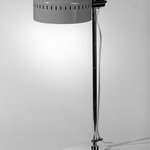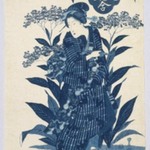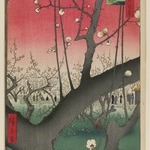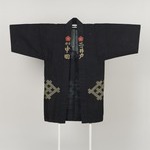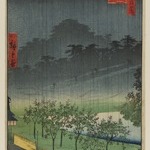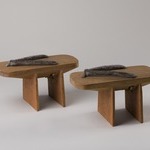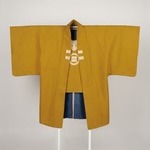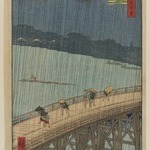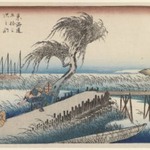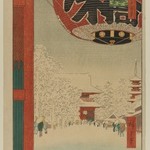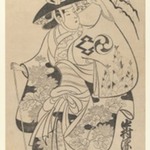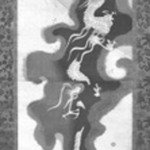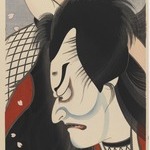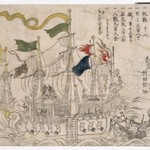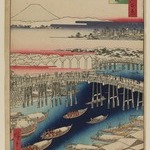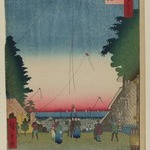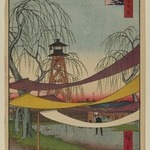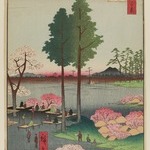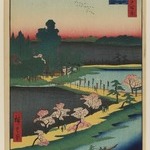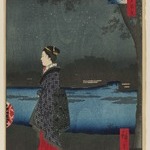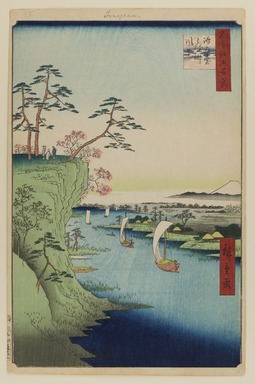
View of Konodai and the Tone River, No. 95 from One Hundred Famous Views of Edo
Utagawa Hiroshige
Asian Art
From the heights of Kōnodai, a site fortified by a series of military barons in the medieval period, Mount Fuji is clearly prominent in the distance. This long bluff along the eastern side of the Tone, now the Edogawa, River is the first high ground of any sort east of the Sumida River, allowing an uninterrupted panorama to the southwest over the seven-mile interval of flat delta area stretching out to Fuji.
MEDIUM
Woodblock print
DATES
5th month of 1856
PERIOD
Edo Period, Ansei Era
DIMENSIONS
Sheet: 14 3/16 x 9 1/4 in. (36 x 23.5 cm)
Image: 13 3/8 x 8 3/4 in. (34 x 22.2 cm) (show scale)



MARKINGS
Publisher: Shitaya Uo Ei.
SIGNATURE
Hiroshige-ga
COLLECTIONS
Asian Art
ACCESSION NUMBER
30.1478.95
CREDIT LINE
Gift of Anna Ferris
PROVENANCE
Prior to 1930, provenance not yet documented; by 1930, acquired by Anna Ferris of Summit, NJ; 1930, gift of Anna Ferris to the Brooklyn Museum.
Provenance FAQ
CATALOGUE DESCRIPTION
This view is situated on the heights of Konodai on an autumn day looking at three figures on a long bluff on the eastern side of the Edogawa River and a view of Mt. Fuji at the right. This cliff served as a regional military center from early times and was the location of the capital of Shimoosa Province in ancient Japan when it was given the name of Kofufu no Dai, "Provincial Capital Bluff," shortened to Konodai. The site was fortified by a series of military barons, finally crushed by the Hojo of Odawara in a battle in 1564. Konodai has been best known for its role in the epic novel by Takizawa Bakin, "Biographies of the Eight Dogs" (1814-1841). The legacy is commemorated today in the name of the public park which occupies the old castle site high on the bluff. The Tone River of the title is the present Edogawa River (see print 71 of the series) and the boats here are bound for Edo by way of the Shinkawa and Onagi Canals (print 70).
EXHIBITIONS
MUSEUM LOCATION
This item is not on view
CAPTION
Utagawa Hiroshige (Japanese, 1797–1858). View of Konodai and the Tone River, No. 95 from One Hundred Famous Views of Edo, 5th month of 1856. Woodblock print, Sheet: 14 3/16 x 9 1/4 in. (36 x 23.5 cm). Brooklyn Museum, Gift of Anna Ferris, 30.1478.95 (Photo: Brooklyn Museum, 30.1478.95_PS20.jpg)
IMAGE
overall, 30.1478.95_PS20.jpg. Brooklyn Museum photograph, 2023
"CUR" at the beginning of an image file name means that the image was created by a curatorial staff member. These study images may be digital point-and-shoot photographs, when we don\'t yet have high-quality studio photography, or they may be scans of older negatives, slides, or photographic prints, providing historical documentation of the object.
RIGHTS STATEMENT
No known copyright restrictions
This work may be in the public domain in the United States. Works created by United States and non-United States nationals published prior to 1923 are in the public domain, subject to the terms of any applicable treaty or agreement.
You may download and use Brooklyn Museum images of this work. Please include caption information from this page and credit the Brooklyn Museum. If you need a high resolution file, please fill out our online application form (charges apply).
The Museum does not warrant that the use of this work will not infringe on the rights of third parties, such as artists or artists' heirs holding the rights to the work. It is your responsibility to determine and satisfy copyright or other use restrictions before copying, transmitting, or making other use of protected items beyond that allowed by "fair use," as such term is understood under the United States Copyright Act.
The Brooklyn Museum makes no representations or warranties with respect to the application or terms of any international agreement governing copyright protection in the United States for works created by foreign nationals.
For further information about copyright, we recommend resources at the United States Library of Congress, Cornell University, Copyright and Cultural Institutions: Guidelines for U.S. Libraries, Archives, and Museums, and Copyright Watch.
For more information about the Museum's rights project, including how rights types are assigned, please see our blog posts on copyright.
If you have any information regarding this work and rights to it, please contact copyright@brooklynmuseum.org.
RECORD COMPLETENESS
Not every record you will find here is complete. More information is available for some works than for others, and some entries have been updated more recently. Records are frequently reviewed and revised, and we welcome any additional information you might have.
